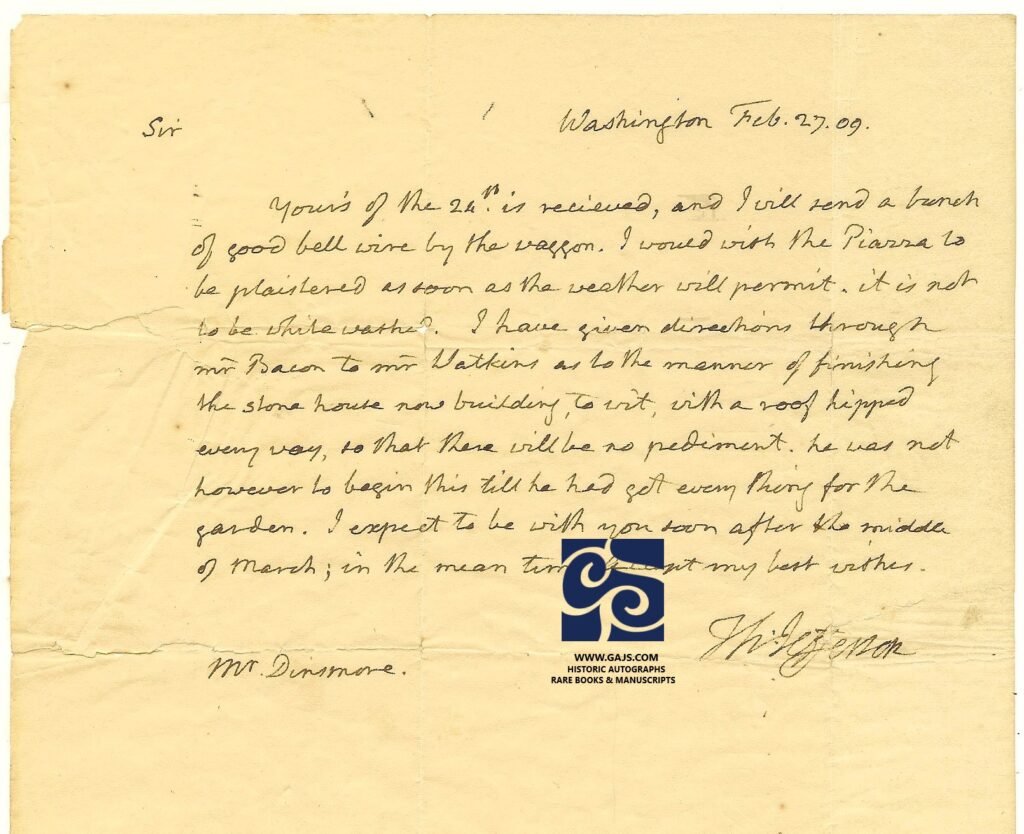THOMAS JEFFERSON
AS HE PREPARES TO LEAVE THE OFFICE OF THE PRESIDENT
INSTRUCTS JAMES DINSMORE, TO PLASTER
THE PIAZZA AS SOON AS THE WEATHER WILL ALLOW
AT HIS BELOVED HOME, MONTICELLO
JEFFERSON, THOMAS. (1743-1826). Third President of the United States, principle author of the Declaration of Independence, and influential Founding Father of the United States. Choice, apparently unpublished, Autograph Letter Signed, “Th. Jefferson,” as President. To Mr. [James] Dinsmore. February 27, 1809. One page, quarto. Washington [D.C.] Jefferson, as he prepares to leave the Oval Office, in just 6 days at the end of his term, writes:
“Sir – Your’s of the 24th. is recieved [sic], and I will send a bunch of good bell wire by the wagon. I would wish the Piazza to be plastered as soon as the weather will permit. It is not to be whitewashed. I have given directions through Mr. Bacon to Mr. Watkins as to the manner of finishing the stone house now building, to wit, with a roof hipped every way, so that there will be no pediment. He was not however to begin this till he had got everything for the garden. I expect to be with you soon after the middle of March; in the mean time accept my best wishes. Th Jefferson”.
Our letter is apparently unknown to the editors of the Jefferson Papers Project and the Founders online project, making it an important addition to the history of Jefferson’s Monticello. We attach, at the conclusion of our description, a transcript of the letter Dinsmore wrote to Jefferson which prompted this reply.
Built and modified constantly over the course of 40 years, the buildings and grounds of Monticello developed into a breathtaking amalgam of Roman, French, and Palladian styles nestled in the Virginia countryside. During Jefferson’s travels in Europe, his study of architecture inspired him to undertake an extensive renovation of his Virginia home. Completed in 1809, this renovation was performed by a myriad of the new nation’s most talented and skilled laborers, including the recipient of our letter, James Dinsmore.
James Dinsmore (c. 1771 – 1830) was the Irish joiner responsible for most of the elegant woodwork in the Monticello house. Dinsmore worked at Monticello from October 1798 to 1809 creating decorative interior woodwork for the main house and training his assistant, Monticello’s enslaved joiner John Hemmings. After his departure from Monticello, Dinsmore went on to work on other buildings in Virginia, including the University of Virginia and James Madison’s home, Montpelier.
Just an out standing letter concerning the construction of Monticello, one of America’s most famous residences.
$29,500.00
From the Founders Online website: To Thomas Jefferson from James Dinsmore, 24 February 1809 — Monticello Feb 24th. 1809
Sir, Your favour of the 30th ult. enclosing Checks on the bank of virginia in favour of Mr Nelson & My Self for five hundred Dollars each were duly received, & have been honoured at the Bank. Mr Nelson also received by last post fifty Dollars—I am now hanging the Bells & find that we will have to use a Single Crank in each of them owing to the off sett in wall at the bottom of the cellar joist, it gives a great deal of trouble in getting the holes through; you will please to bring a bunch of wire with you fit for Bell hanging as what is here is not to be depended on—We have nearly finished the Cornice haveing only a few peices of the egg & dart Moulding to Carve. My Principal motive in writing to you at this time is to know whether you wish to have the Piazza plaistered now, as I look for Mr Chisholme by Court, it would be some object to save a second Scaffolding, I have had laths got for the Ceiling—You will plase to mention whether the stone house now building is to be finished with a pediment & if so, will the tympan be of stone like the present stone house or plaistered like the Pavillions as it will make some difference in carrying up the shaft of the Chimney—you will please to mention to Mr. Madison that we expect to move to his place some time in the latter end of March. I am Sir with respect your very Humble Servant Jas. Dinsmore”.
